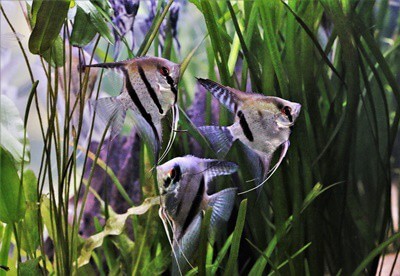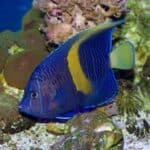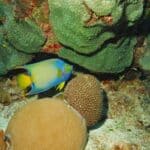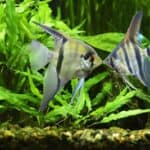Last Updated on: 17th October 2023, 09:17 am
Swim bladder disease in angelfish results in the fish swimming oddly or frantically. The disorder is progressive, eventually rendering the fish unable to swim correctly.
Unable to maintain buoyancy, it floats upside down or on its side. A badly affected swim bladder is usually a symptom of another illness rather than a standalone disorder.
The most common trigger is improper tank parameters that result in constipation.
Over-feeding, which also results in constipation, can escalate to the point of being deadly. Providing a healthy tank and a well-optimized diet goes a long way toward preventing this disorder.
Untreated swim bladder disorder will eventually lead to the fish being unable to breathe or eat properly. If the trigger doesn’t kill the fish by itself, this will.
There are effective swim bladder disorder treatments, including feeding them cooked peas, correcting tank parameters, and vet-prescribed medications.
What Causes Swim Bladder Disease In Angelfish?
Swim bladder disease, also called swim bladder disorder, is the name given to a broad collection of issues that affect the swim bladder. It results in the fish being unable to swim or orient itself properly.
Swim bladder disease is usually a symptom of specific issues, not a primary problem with the bladder. We can broadly group the causes of swim bladder disease into four categories:
- Incorrect tank conditions.
- Birth defects.
- Parasitic or bacterial infection.
- Over-feeding.
Non-treatment will result in an unhealthy fish with a low quality of life. Eventually, the angelfish will die.
Angelfish Swimming Weird
The first sign is usually your fish ‘swimming weird.’ This is because a swim bladder that functions correctly will allow your fish to swim in clear, straight lines without wavering.
The swim bladder is an organ in fish filled with gas and air. According to Respiratory Physiology and Neurobiology, this organ enables fish to float at specific depths in the water without actively swimming. This helps to:
- Conserve energy.
- Let the fish have moments of low activity or rest.
- Maintain camouflage because predatory fish float to blend in before ambushing their prey.
Certain fish can control their buoyancy by increasing or decreasing the gas in the swim bladder. Other fish maintain a fixed amount that doesn’t change unless forced to.
The location of the swim bladder can change depending on fish species. However, it’s usually found in the cavity below the spine and above the belly.
Not all fish have a swim bladder and achieve desired buoyancy through other means. In angelfish, the swim bladder is near the center of the body, along the lateral line, and starting behind the eye.

What Causes Swim Bladder Disease In Angelfish?
Understanding the causes of swim bladder disease can help you prevent specific triggers for the ailment. It can also help you diagnose existing issues with your angelfish.
Aquatic veterinarians can help you assess your tank and its unique issues. You can also reach out to local aquariums or pet shops. They have a wealth of experience with swim bladder disease and can usually perform tests on any water samples you provide.
You can also try to diagnose the problem at home. Let’s explore the factors that might’ve caused the swim bladder issue to crop up in your tank.
Incorrect Tank Conditions
Poor tank conditions are the leading cause of swim bladder disease. Your fish may have a range of ailments if they live in a tank with:
- Dirty water.
- Water that’s too hot or cold.
- An incorrect pH balance.
- The wrong measure of nitrates.
Individually, these factors may cause swim bladder issues in angelfish. Even though angelfish are considered a hardier fish, tolerant of a wide range of conditions, improper conditions will impact their quality of life.
For example, a too-cold tank will affect how effectively fish can digest and metabolize food. This can lead to impaction, which applies pressure to the swim bladder and can lead to swim bladder disease.
Dirty water or water with an incorrect pH balance may also cause the fish to internalize bacteria or diseases. This can disrupt its immune system, damage its organs, and eventually hurt the swim bladder. The ideal tank conditions for angelfish are as follows:
| Temperature Range | 78° F – 84° F |
| pH Range | 6.8 – 7.8 |
| Hardness | 54 – 145 ppm |
Birth Defects
Like any other living organism, fish can grow defects early in life. Occasionally, these defects will be within the swim bladder itself. They may also be on neighboring tissues, organs, or skeletal structures. Such defects will apply pressure or damage to the swim bladder.
Goldfish, koi, and betta fish are known for developmental defects that cause swim bladder disorder.
In a study on one species of angelfish, Pterophyllum scalare, Aquaculture found that multiple larvae from a single clutch had incorrectly developed swim bladders.
If your angelfish has a birth defect that impacts its ability to swim properly, it will typically die before adulthood. If your angelfish is much older, it’s either lucky, or the condition has a different cause.
Parasitic or Bacterial Infection
Any parasite or bacterial infection that attacks the swim bladder can quickly trigger swim bladder disease. Parasites found in aquariums that cause such damage are rare but not unheard of.
Injuries can cause the swim bladder to rupture or open a wound ripe for infection – especially in tanks with poor water quality. These injuries can come from the fish swimming into a hard or sharp object or fighting, as most cichlids are known for.
Issues with the surrounding organs can also press on the swim bladder, such as cyst formation or egg binding. There is little that can be done for such fish.
Over-Feeding
Over-feeding causes many problems in all types of fish, including angelfish. The same applies to feeding too much freeze-dried food (as it expands in water) or incorrect food. Angelfish are omnivores that require a diet composed of plant and animal matter. Only providing the fish with one can cause a nutritional deficiency, among other things.
A result of improper diet and over-feeding is constipation. Swelling of the intestine can push on the swim bladder organ, causing problems. Over-feeding can result in mild swim bladder disorder, resulting in difficulty swimming.
Usually, this fades within a few hours as the fish’s body digests the food. If your fish struggles to swim after eating, cut back on how much it’s fed.
What Does Swim Bladder Disease Look Like?
Swim bladder disease presents itself in several easily observed ways.
Most people notice when the fish begins swimming abnormally because swim bladder disease makes it difficult for fish to maintain equilibrium and move around the tank.
This will appear as the fish struggling to remain upright.
- It’ll swim on an angle.
- It’ll swim upside down.
- I’ll try to right itself, only to flip back over.
Buoyancy issues will also manifest. This will show as the fish:
- It sinks to the bottom of the tank, looking as if it is resting on the bottom.
- Floats at the surface, bobbing there on its side.
- The angelfish may also appear to swim frantically as it struggles against its lack of control.
Swim bladder disease will also impact your angelfish’s appetite. It will:
- Lack appetite.
- Be unable to eat correctly.
- Have a bloated belly, curved back, or other unusual bulges in its abdomen.
Angelfish that are in critical condition may also appear lethargic. After all, fighting against your balance is exhausting. Also, it may be dying, which will further sap its energy.
Why Is My Fish Swimming Vertically Head Up?
Your diseased fish may also begin swimming straight up and down. Before the disorder sets in, the swim bladder will only be partially damaged. It will do a half-good, half-bad job of keeping your fish upright, which may cause the fish to:
- Float at an angle.
- Float with its tail higher than its nose.
- Float with its head up vertically.
Issues with the swim bladder can cause a range of odd buoyancy issues.
If you notice this, be sure to examine the fish closely. If you see it trying to swim frantically or showing body defects, this will help confirm the sickness.
If you don’t notice any other symptoms, check your filter. Sometimes, a filter’s output is too hard, making it difficult for the fish to swim correctly. Angelfish need a gentle current.
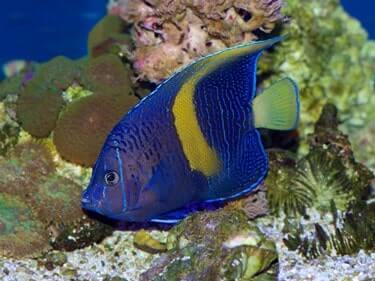
Dropsy Or Swim Bladder Disease
It’s easy for new fish-keepers to misdiagnose their angelfish with dropsy. Both dropsy and swim bladder disease will cause your fish to float oddly or swim erratically.
Dropsy has symptoms that set it apart:
- Your fish will have pine-coned scales that protrude from its body.
- It will heavily bloat and be unable to eat.
Dropsy is relatively easy to treat, although it’s fatal if you don’t address it quickly. It’s a kidney disease that will shut down your fish’s organs. If you notice the above symptoms, you can treat the fish with Epsom salt and a mild dose of kanaplex.
Can Fish Die From Swim Bladder Disease?
Is swim bladder disease fatal? It can be. If your fish isn’t adequately treated, it’ll be deadly.
It’s a symptom of many issues. Your fish may be more or less likely to die based on the disease.
According to the Midland Veterinary Surgery, several terminal illnesses trigger swim bladder disease. Severe constipation or infection may be one of these issues.
On its own, swim bladder disease will make it extremely difficult for the fish to:
- Swim.
- Eat.
- Breathe.
This alone may eventually cause it to die. If you suspect your angelfish has swim bladder disease, get on top of it immediately.
How To Treat Swim Bladder Disease
Treatment for swim bladder disease will depend on what has caused the disorder to develop in the first place. If you can’t determine the cause yet, start with the basics:
Check The Tank
Check the parameters of your tank and setup. You may find an imbalance in the water’s
- Temperature
- Hardness
- Acidity
Should anything be unusual, perform a 20% water change and correct the parameters. You may also want to add aquarium salt to help the fish recover.
Quarantine The Fish
In most cases, it’s wise to put the fish in a separate quarantine tank. This simplifies treatment and stops other fish from picking on the weak tank mate.
Separating the afflicted fish from others also makes the next treatment option simpler.
Change Filter And Temperature
Lower the filter output current to a gentler setting. This will keep weakened fish from being pushed around the tank, which could:
- Exhaust it.
- Cause it to bump into objects.
- Make it hard to eat.
Alongside this, you should adjust the temperature of your tank. As tropical fish, angels do best in warm water. A setting of 80° F will give your angelfish the comfort it needs to begin healing.
Treatment For Different Causes
Now, it’s time to be more specific. These treatments apply to the different root causes of the disease.
Impaction
If your tank conditions are otherwise fine, the most common reason for swim bladder disease is constipation or food impaction.
Change Diet
In this case, you should not feed the fish for 2-3 days. It may seem cruel, but this prevents additional food from blocking the fish’s internal systems.
After this period, feed the fish a cooked and skinned pea. Just one! These fish are small, and yours already has a stomach issue. Peas are full of fiber and great for helping matter to shift through the stomach and intestines.
Repeat this once a day for an additional 2-3 days. If the fish shows signs of recovery, you can begin alternating between peas and everyday fish food. It’s best to avoid:
- Freeze-dried foods.
- Flakes.
- Floating pellets
These can hamper recovery. Instead, live brine shrimp or frozen-thawed brine shrimp are an excellent choice. Angelfish in this stage need protein.
Hand-Feed
If your fish struggles to swim, it may also have difficulty eating. This will require you to hand-feed the fish. A different treatment is needed if the fish refuses to eat or this treatment is ineffective.
It’s also possible that the disease has progressed too far. If it’s dying, discuss euthanasia with a vet.
Infection
You must treat the entire aquarium if the disease results from an infection. Anti-bacterial solutions can be added to the tank, which helps if a bacterial infection enters the fish internally.
You can find options at your local pet shop or contact your vet to receive stronger medications.
You can also add a small amount of aquarium salt to the tank. This will ensure the angelfish are hydrated and full of electrolytes.
Defects
If your fish has a birth defect, this will require a vet’s intervention. A professional can perform corrective surgery on the fish. In some cases, this:
- Repairs any damage to the organ.
- Removes liquids from the bladder.
- Relieves excess gas from the bladder.
A vet may surgically attach a floating harness to the fish if its swim bladder is inflated. This allows it to remain upright and closer to the surface so the bladder can return to normal and extend.
Vets can also prescribe antibiotics unavailable as over-the-counter purchases. These will be a more targeted medication rather than a broad-spectrum solution.
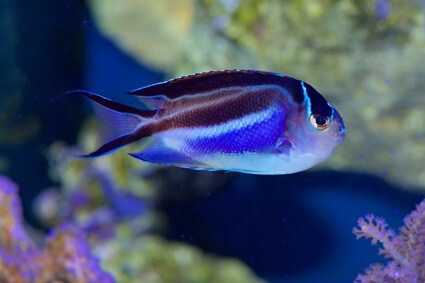
Can Swim Bladder Disease Go Away On Its Own?
Swim bladder disease will only resolve in one scenario: if it’s triggered by light constipation.
The angelfish may recover from constipation without your intervention or dietary changes. The swim bladder issues will then resolve themselves.
However, in most cases, angelfish don’t recover from swim bladder disease without assistance. It’ll take some form of intervention and treatment on your part.
The condition will worsen until the fish can’t swim or breathe properly.
Is Swim Bladder Disease Contagious?
Thankfully, those with community tanks need not worry about a contagious outbreak. Swim bladder disease isn’t infectious to other fish.
That said, depending on what caused one fish to develop this disease, others may soon follow. That’s why diagnosing and resolving the problem is critical. For example, poor water quality or a chemical imbalance will lead to multiple issues with the fish.
Do Fish Suffer With Swim Bladder Disease?
No one wants their pets to suffer. Sadly, a fish with swim bladder disease that isn’t responding to treatment isn’t going to get better.
Even if your vet attached a floating harness to aid the fish in its recovery, this is only a temporary fix. Anywhere it makes contact with the angelfish’s skin will eventually grow sores and infection.
As you may fear, this isn’t good for the fish’s quality of life. If swim bladder disease cannot be stopped and reversed with treatment, it’s time to speak to your vet about humane euthanasia.
A recovered angelfish with a permanently damaged or defective swim bladder may be unaffected. That’s only true if it’s still able to swim primarily upright. You must accommodate its inability to swim by using a gentle filter output and hand-feeding it.
Preventing Swim Bladder Disease
Preventing swim bladder disease is relatively simple, all told. Let’s begin there since the most common cause is improper tank parameters.
Check Water Parameters
Angelfish are hardy but thrive in properly heated water with a gentle filter output. Ensure that your tank is set to the parameters noted earlier.
Check Filtration
Are you only using mechanical filter media? Swap part of it for a biochemical filter media that removes nitrates and ammonia from the water. This improves the water quality and eliminates impurities, stopping harmful bacteria populations from exploding.
Avoid Keeping Too Many Fish
Over-crowded tanks are susceptible to the above problems. Be sure to not over-populate your tank.
Check Diet
Next is the diet. Include variations in the food you feed the fish, rotating between:
- Frozen foods.
- Granules.
- Pellets.
- Flakes.
This will ensure your fish’s nutritional needs are being met.
Avoid Over-Feeding
Only provide an amount of food that can be eaten within 2-3 minutes. That’s especially true for dried foods, like flakes and pellets.
These foods continue to expand in the angelfish’s stomach, causing constipation and impaction. It helps to soak dried foods in water before feeding them to the fish.
Clean Your Tank
Be sure to perform regular tank maintenance. This will keep the water clean and the tank healthy.
Swim bladder disease is common in aquarium fish of all types. If you keep the tank conditions healthy and watch for signs of infection, the angelfish will be less likely to develop.

